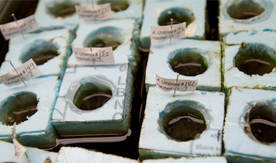
Old Town Science Students Part of UMaine Research on Mercury Contamination
Old Town High School senior Andrew Brothers says the dragonfly larvae and zooplankton in teacher Ed Lindsey’s science lab are even more fun than the ant farm he had as a kid.
But the project Brothers is working on is far from child’s play.
Brothers, along with senior Samantha Emerson, and sophomores Christine Pollard and Jaime Lemery, are collaborating with University of Maine researcher Sarah Nelson, who is using dragonfly larvae as bio-sentinels for mercury in wetlands, stream watersheds and lakes across the Northeast.
In their classroom laboratory, the students have set up mesocosms — mini-ecosystems in the form of tanks of circulated stream water from Baker Brook in Sunkhaze Meadows National Wildlife Refuge in Milford, Maine — where 300 dragonfly eggs gathered from adult dragonflies they captured have hatched.
Now that the eggs have hatched and the dragonfly larvae are eating, growing and molting, the students are collecting data to find out how — and at what rate — mercury accumulates as the dragonfly larvae grow.
They’re periodically measuring mercury in the water, zooplankton, larvae and exoskeletons the young dragonflies shed. UMaine’s Sawyer Environmental Chemistry Research Lab will analyze the samples with a direct mercury analyzer. The goal is to shed light on the patterns of mercury accumulation as dragonflies grow from egg to adult, informing research on the use of dragonflies as local indicators of how mercury moves up food chains.
In humans, low-grade chronic mercury exposure can impair cognitive functions and diminish motor skills, says Nelson. People are predominantly exposed to mercury, a heavy, toxic metal, from eating contaminated fish.
This is an independent study project for the high students, who are pioneers of sorts for building the mini-ecosystems and raising dragonflies. Nelson says one of the only reference materials they could locate about the topic was a book written in the 1920s.
The dragonfly larvae are fed zooplankton that the students are growing in tanks of Baker Brook water. The zooplankton is raised on neon green phytoplankton, grown in an apparatus Brothers built.
“They’re cool little creatures,” Brothers says of the zooplankton, which are barely visible to the naked eye. “They corral around like dogs to a food bowl when they’re being fed.”
The dragonfly larvae are also interesting. Lemery calls them “tenacious and mobile little soldiers” that sometimes escape from their containers. Each larva is housed in a separate container in the water tanks. Nelson says they would devour each other if they were kept together. It typically takes between one and five years for a dragonfly egg to become an adult, she says.
The science students are mentored by Lindsey, one of 18 educators nationwide who received the 2012 Presidential Innovation Award. Lindsey, who teaches earth science and chemistry at Old Town High School, purchased equipment, including microscopes, with the award money he received. He described the research project as authentic and a public service.
Nelson is a scientist with UMaine’s Sen. George J. Mitchell Center for Environmental and Watershed Research and School of Forest Resources. Her research interests are watershed geochemistry, atmospheric deposition and mercury.
Last May, Old Town students joined more than 200 of their peers and science teachers from Bangor, John Bapst, Mount View and Sumner Memorial high schools in presenting findings from their research on mercury in local watersheds as part of Acadia Learning. A partnership among the Schoodic Education and Research Center (SERC) Institute at Acadia National Park, UMaine’s Mitchell Center, and Maine Sea Grant, Acadia Learning works to train and support teachers for research designed to engage high school students in sample collection and data analysis for mercury. UMaine’s Sawyer Environmental Chemistry Research Laboratory analyzes the samples.
Students use the data to investigate their own research questions about how mercury accumulates in food chains in local streams. The data have become part of a regional database coordinated by Nelson, adding to a regional picture of mercury in fresh waters across the Northeast. The National Oceanic and Atmospheric Administration, the Maine Department of Education, private donors and the Davis Foundation fund Acadia Learning.
The school-based program is the springboard for a newly launched citizen scientist project by the Nelson and the National Park Service to study mercury in dragonfly larvae. The nymphs collected in national parks nationwide are being sent to UMaine and Dartmouth College laboratories for analysis. According to the National Park Service website on the citizen scientist project, the goal is to better understand human-caused mercury contamination in national park environments and “characterizing the risk and potential transfer of mercury around food webs.”
